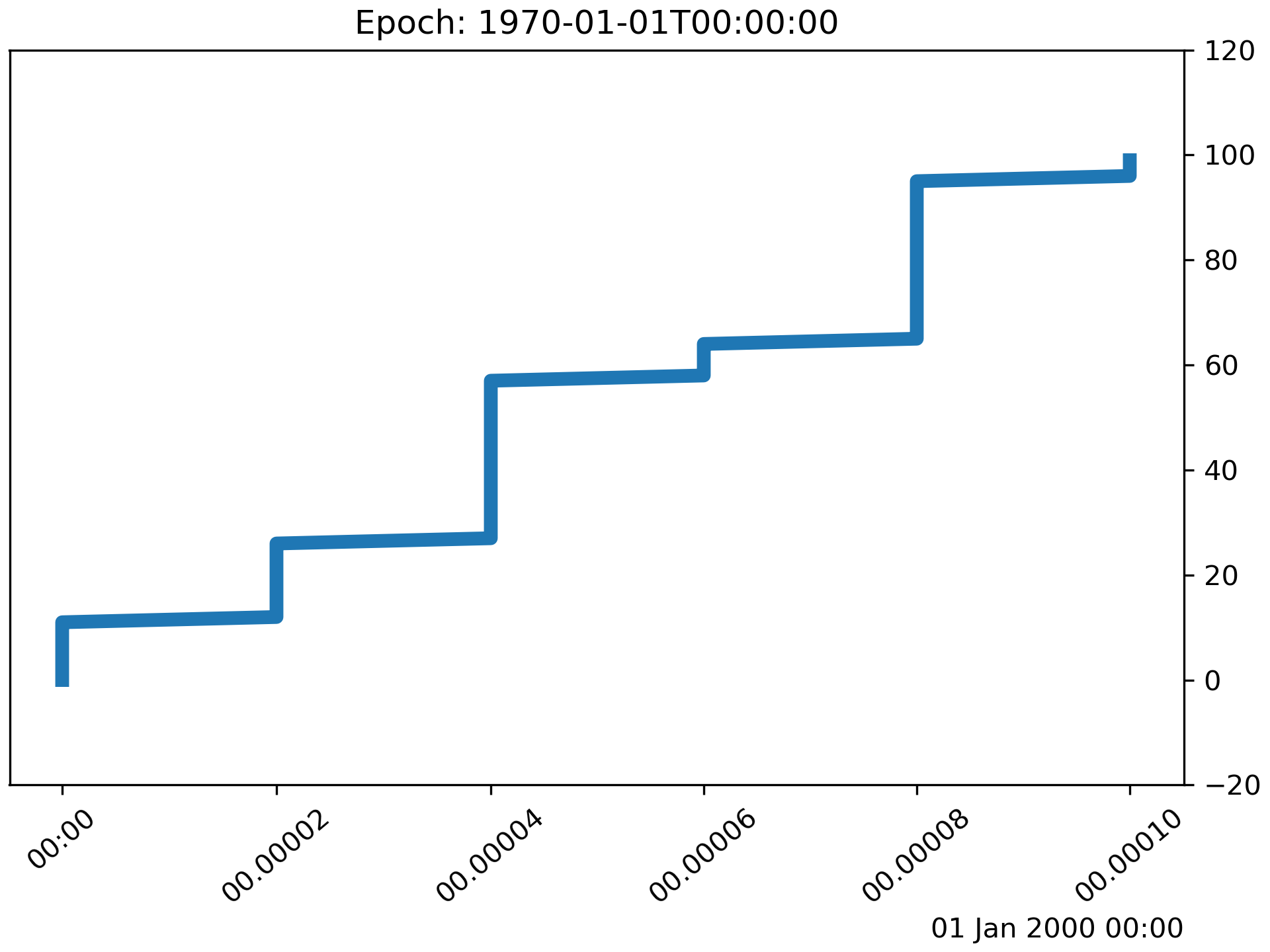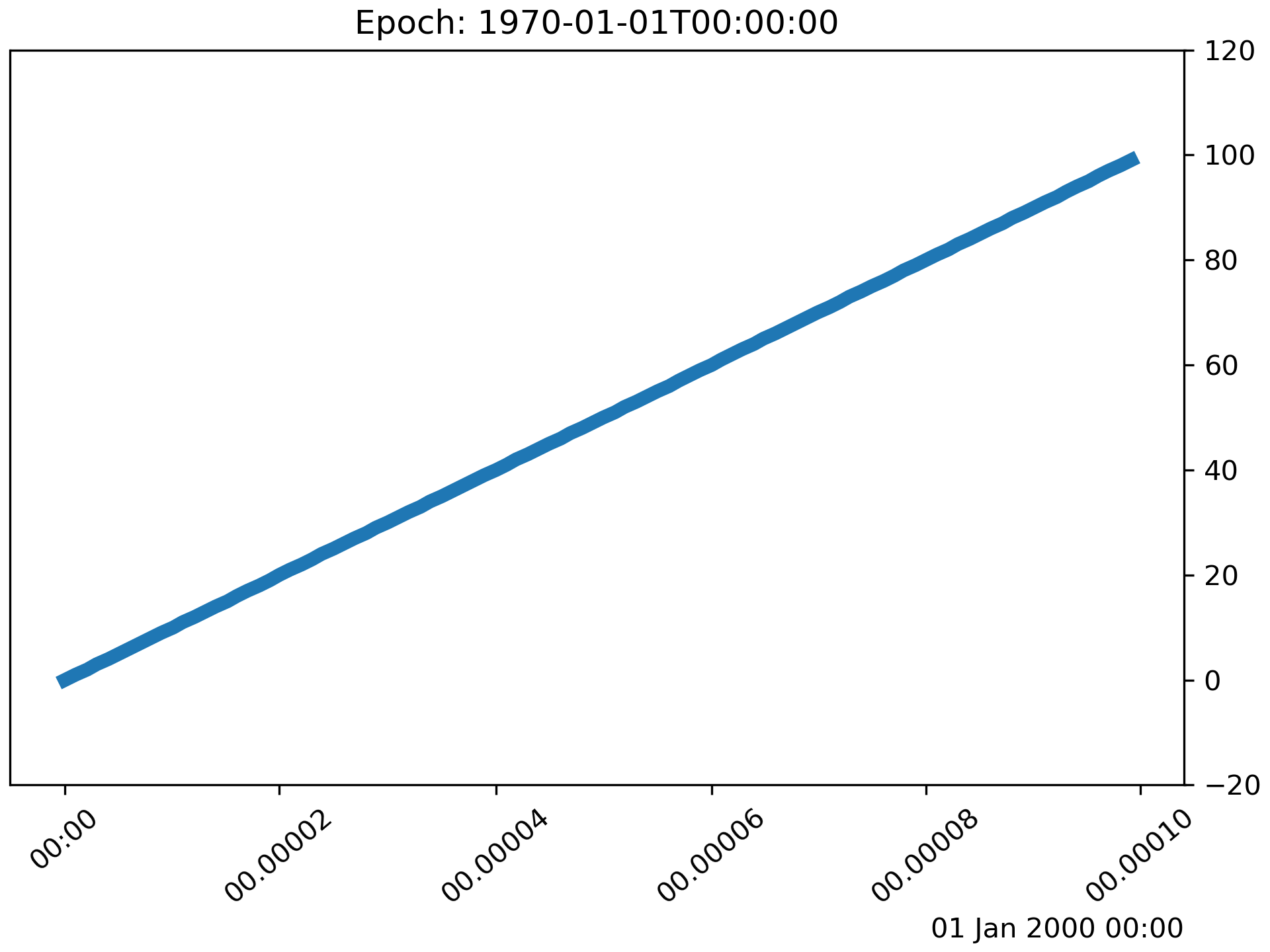>>> """
=========================
Date Precision and Epochs
=========================
Matplotlib can handle `.datetime` objects and `numpy.datetime64` objects using
a unit converter that recognizes these dates and converts them to floating
point numbers.
Before Matplotlib 3.3, the default for this conversion returns a float that was
days since "0000-12-31T00:00:00". As of Matplotlib 3.3, the default is
days from "1970-01-01T00:00:00". This allows more resolution for modern
dates. "2020-01-01" with the old epoch converted to 730120, and a 64-bit
floating point number has a resolution of 2^{-52}, or approximately
14 microseconds, so microsecond precision was lost. With the new default
epoch "2020-01-01" is 10957.0, so the achievable resolution is 0.21
microseconds.
"""
... import datetime
... import numpy as np
...
... import matplotlib.pyplot as plt
... import matplotlib.dates as mdates
...
...
... def _reset_epoch_for_tutorial():
... """
Users (and downstream libraries) should not use the private method of
resetting the epoch.
"""
... mdates._reset_epoch_test_example()
...
...
... #############################################################################
... # Datetime
... # --------
... #
... # Python `.datetime` objects have microsecond resolution, so with the
... # old default matplotlib dates could not round-trip full-resolution datetime
... # objects.
...
... old_epoch = '0000-12-31T00:00:00'
... new_epoch = '1970-01-01T00:00:00'
...
... _reset_epoch_for_tutorial() # Don't do this. Just for this tutorial.
... mdates.set_epoch(old_epoch) # old epoch (pre MPL 3.3)
...
... date1 = datetime.datetime(2000, 1, 1, 0, 10, 0, 12,
... tzinfo=datetime.timezone.utc)
... mdate1 = mdates.date2num(date1)
... print('Before Roundtrip: ', date1, 'Matplotlib date:', mdate1)
... date2 = mdates.num2date(mdate1)
... print('After Roundtrip: ', date2)
...
... #############################################################################
... # Note this is only a round-off error, and there is no problem for
... # dates closer to the old epoch:
...
... date1 = datetime.datetime(10, 1, 1, 0, 10, 0, 12,
... tzinfo=datetime.timezone.utc)
... mdate1 = mdates.date2num(date1)
... print('Before Roundtrip: ', date1, 'Matplotlib date:', mdate1)
... date2 = mdates.num2date(mdate1)
... print('After Roundtrip: ', date2)
...
... #############################################################################
... # If a user wants to use modern dates at microsecond precision, they
... # can change the epoch using `.set_epoch`. However, the epoch has to be
... # set before any date operations to prevent confusion between different
... # epochs. Trying to change the epoch later will raise a `RuntimeError`.
...
... try:
... mdates.set_epoch(new_epoch) # this is the new MPL 3.3 default.
... except RuntimeError as e:
... print('RuntimeError:', str(e))
...
... #############################################################################
... # For this tutorial, we reset the sentinel using a private method, but users
... # should just set the epoch once, if at all.
...
... _reset_epoch_for_tutorial() # Just being done for this tutorial.
... mdates.set_epoch(new_epoch)
...
... date1 = datetime.datetime(2020, 1, 1, 0, 10, 0, 12,
... tzinfo=datetime.timezone.utc)
... mdate1 = mdates.date2num(date1)
... print('Before Roundtrip: ', date1, 'Matplotlib date:', mdate1)
... date2 = mdates.num2date(mdate1)
... print('After Roundtrip: ', date2)
...
... #############################################################################
... # datetime64
... # ----------
... #
... # `numpy.datetime64` objects have microsecond precision for a much larger
... # timespace than `.datetime` objects. However, currently Matplotlib time is
... # only converted back to datetime objects, which have microsecond resolution,
... # and years that only span 0000 to 9999.
...
... _reset_epoch_for_tutorial() # Don't do this. Just for this tutorial.
... mdates.set_epoch(new_epoch)
...
... date1 = np.datetime64('2000-01-01T00:10:00.000012')
... mdate1 = mdates.date2num(date1)
... print('Before Roundtrip: ', date1, 'Matplotlib date:', mdate1)
... date2 = mdates.num2date(mdate1)
... print('After Roundtrip: ', date2)
...
... #############################################################################
... # Plotting
... # --------
... #
... # This all of course has an effect on plotting. With the old default epoch
... # the times were rounded during the internal ``date2num`` conversion, leading
... # to jumps in the data:
...
... _reset_epoch_for_tutorial() # Don't do this. Just for this tutorial.
... mdates.set_epoch(old_epoch)
...
... x = np.arange('2000-01-01T00:00:00.0', '2000-01-01T00:00:00.000100',
... dtype='datetime64[us]')
... # simulate the plot being made using the old epoch
... xold = np.array([mdates.num2date(mdates.date2num(d)) for d in x])
... y = np.arange(0, len(x))
...
... # resetting the Epoch so plots are comparable
... _reset_epoch_for_tutorial() # Don't do this. Just for this tutorial.
... mdates.set_epoch(new_epoch)
...
... fig, ax = plt.subplots(constrained_layout=True)
... ax.plot(xold, y)
... ax.set_title('Epoch: ' + mdates.get_epoch())
... ax.xaxis.set_tick_params(rotation=40)
... plt.show()
...
... #############################################################################
... # For dates plotted using the more recent epoch, the plot is smooth:
...
... fig, ax = plt.subplots(constrained_layout=True)
... ax.plot(x, y)
... ax.set_title('Epoch: ' + mdates.get_epoch())
... ax.xaxis.set_tick_params(rotation=40)
... plt.show()
...
... _reset_epoch_for_tutorial() # Don't do this. Just for this tutorial.
...
... #############################################################################
... #
... # .. admonition:: References
... #
... # The use of the following functions, methods, classes and modules is shown
... # in this example:
... #
... # - `matplotlib.dates.num2date`
... # - `matplotlib.dates.date2num`
... # - `matplotlib.dates.set_epoch`
...



